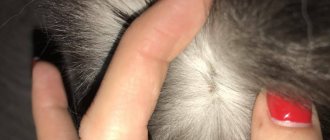Helminthiasis is a fairly popular disease of worms in the animal world, during which parasitic worms - helminths, as well as their larvae - settle in the internal environment of the affected animal's body. Humans, like cats, who have lived together since ancient times, are subject to helminthic infestations to the same extent.
Clinical manifestations of the disease stem from disruption and damage to the functioning of many organs. Therefore, animals need to be treated on time , since a sick four-legged friend suffers not only himself and requires the help of the owner, members of the family where the cat lives can also be affected.
In the article we will look at the most common types of parasites in animals, signs of the disease, and also - we will answer one of the most frequently asked questions - how to cure worms in a cat and what the parasites look like.
Where does a cat get worms?
Not only stray animals can become infected with helminthiasis. Worms occur quite often in cats that live in apartments and private houses. Of course, free-ranging pets are at greatest risk of infection. Helminth eggs can be found on grass, sand and soil. They remain on the fur, and when the cat licks itself, it enters the digestive tract.
A person can bring parasite eggs into an apartment on his shoes or clothes.
There are other ways of infection with helminthic infestation:
- Eating raw river fish, meat and minced meat.
- Close contact with an infected animal. Helminth infections are transmitted by using a common tray or equipment.
- Some types of worms are transmitted to kittens through the milk of a nursing mother.
- Fleas and lice eaters are carriers of helminthiasis. If a cat has ectoparasites, the risk of infection with worms cannot be ruled out.
What parasites and how are they transmitted to humans from cats?
Having a pet, especially a cat, is an almost 100% guarantee that all family members, and especially small children, will be affected by worms if they do not follow certain rules. Never kiss or allow a cat to lick your face; after any stroking of the cat, even if it was a fleeting movement of the palm on the back or head, you need to wash your hands.
Cats are quite clean, they spend almost all their free time washing themselves and licking their fur, but this neatness can lead to the fact that parasite eggs are distributed evenly throughout the entire coat from the tip of the nose to the tail. The tongue is the most dangerous and the biggest spreader of worms.
Of the 81 varieties of helminths that can infect cats, more than 35 varieties perfectly take root in the human body, the most dangerous of which are considered toxascarosis, toxocariasis and dipylidia . Therefore, make sure that all family members, especially children, take the problem of personal hygiene seriously, and do not let anyone kiss the cat.
Types of helminths in cats
Worms that parasitize cats are divided into several groups:
- Roundworms. Otherwise they are called nematodes.
- Tapeworms (flatworms), or cestodes.
- Flukes are trematodes.
Round (nematodes)
The most common roundworm in cats is roundworms. There are two types of such worms:
- Toxocara cati;
- Toxacaris leonine.
These are light yellow cylindrical worms. Outwardly they look like spaghetti. The average length of these parasites is 7-15 cm. Roundworms settle primarily in the small intestine.
Hookworms are another type of helminthic infestation in cats. The size of parasites usually does not exceed 10 mm. These worms can even enter an animal's body through the skin. Habitat: small intestine.
Heartworms - this type of worms in cats is transmitted by mosquitoes during a bite. These worms can infect the subcutaneous tissue, muscle tissue, heart and lungs. The size of adult individuals reaches 30 cm in length.
Routes of infection
Roundworm eggs enter the body of cats mainly through nutrition:
- when eating raw meat and fish;
- while licking paws and fur.
The source of infection is most often sick animals, which release parasite eggs along with feces into the environment. Worms in a kitten can appear due to an infected mother who feeds her babies with breast milk.
Why are they dangerous?
Roundworms injure the intestinal mucosa and release toxic substances. This leads to poisoning of the body. In addition, they take away some of the cat's nutrients. As a result, exhaustion, anemia occurs, and the body's protective functions decrease. With ascariasis, blockage of the bile ducts and intestinal obstruction are possible.
How to notice
Signs of the presence of roundworms in cats are not immediately detected. Symptoms appear 2-4 weeks after infection. How to understand that your pet has helminths:
- the cat loses its appetite and loses weight;
- Allergic skin rashes may appear;
- diarrhea and constipation occur from time to time;
- there may be blood in the stool;
- the coat loses its well-groomed appearance and looks dull.
With dirofilariasis, the symptoms are specific - shortness of breath, fatigue, swelling. This clinical picture emerges if worms have affected the heart. In the ocular form of the disease, the eyelids become inflamed. If the worms have settled in the subcutaneous tissue, moving formations, ulcers are found on the body, and the hair in these places falls out.
Tape (cestodes)
This group includes worms with a flat body that looks like a ribbon, hence the name. The length of parasites can reach 70 cm. Their oral cavity is equipped with hooks. With their help, worms attach to the intestinal mucosa. As the worms grow, segments about the size of a grain of rice break off from the back of the worm and are passed in the infected animal's feces.
There are several types of tapeworms in cats:
- Cucumber tapeworm. The parasite reaches 50 cm in length and about 3 mm in width. The worm has 4 suckers and a proboscis with spine-like hooks. Its segments resemble cucumber seeds. The tapeworm is a parasite in the small intestine.
- Wide tape. The length of the worm can reach several meters. The intermediate hosts of the tapeworm are copepods and fish.
- Echinococcal tapeworm. These are worms no larger than 4 mm, the larvae of which live in the intestines of cats and dogs. Man, along with other animals, is an intermediate host of Echinococcus.
How do pets become infected?
Tapeworms enter a cat's body in a variety of ways. For example:
- cucumber tapeworm - when ingesting an infected flea or lice eater;
- wide tapeworm - when eating raw river fish;
- Infection with echinococcosis is possible through contact with the feces of a sick animal.
What is the danger
Tapeworms are dangerous to both cats and their owners. They injure the intestinal mucosa and poison the body with the products of their vital activity. Severe infection can cause anemia and blockage of the intestinal lumen.
Attention! A person can become infected with cestodosis from a sick cat if he does not follow the rules of personal hygiene - does not wash his hands after contact with the animal or touches fur contaminated with feces with his lips.
How to see
You can tell that a cat has tapeworms by the following signs:
- segments of helminths are occasionally found in feces;
- the cat has poor appetite;
- vomiting, diarrhea;
- allergic rashes;
- irritation in the anal area;
- apathy, fatigue.
Flukes (trematodes)
These are flat worms that are firmly attached to the cat’s internal organs using powerful suction cups. They can parasitize the liver, bile ducts and lungs. During their life, worms gradually destroy the tissues of internal organs.
The following fluke worms are found in cats:
- cat fluke is a worm up to 1.5 cm long.
- Paragonimus is a red-brown worm slightly more than 1 cm long and up to 0.5 cm wide.
Methods of infection
Cats can become infected with trematodiasis by eating uncooked fish. The development cycle of flukes is quite complex and involves the presence of several intermediate hosts. These could be slugs, snails, fish. In this regard, human infection from a cat is unlikely. Kittens pick up a parasitic infection through their mother's milk.
What amazes
Worms from this group parasitize the tissues of internal organs. For example, the cat fluke lives in the bile ducts. Paragonimus live in the lungs of cats, which is why they are also called pulmonary flukes.
How to determine
You can tell if a cat has worms from the fluke group by the following signs:
- the animal is stunted;
- there is a lack of appetite;
- vomiting occurs periodically, blood may be present in the stool;
- cough, difficulty breathing;
- yellowness of the skin and mucous membranes.
Symptoms of worms in cats
Timely detection of symptoms of helminthic infestation is a guarantee of successful treatment. Signs of helminthiasis differ depending on which organs are affected by worms. In adult cats with strong immune systems, the clinical picture may be mild.
Intestines
The following symptoms indicate that a cat has worms in its intestines:
- the presence of mucus in the stool;
- bloating and abdominal pain;
- vomit;
- loss of appetite;
- diarrhea alternating with constipation;
- increased thirst.
Liver
If worms have infected the liver, symptoms in cats appear differently:
- vomiting bile;
- the skin, mucous membranes and sclera acquire a yellow tint;
- pain on palpation under the ribs on the right.
Heart and lungs
By these signs you can find out about worm damage to the heart and lungs:
- temperature increase;
- fast fatiguability;
- dyspnea;
- noisy breathing;
- cough;
- vomit.
central nervous system
When infected with worms, symptoms may appear that indicate damage to the spinal cord or brain:
- excessive excitement;
- convulsions;
- paralysis of individual parts of the body;
- impaired coordination of movements;
- fainting;
- involuntary urination or bowel movements.
Excretory system
Worms in cats rarely parasitize the genitourinary organs. If your pet begins to go to the toilet more often or less often than usual, and blood appears in the urine, you need to examine it.
The effect of helminths on the animal
Worms are harmful to a cat's health. They deprive their prey of nutrients and vitamins. This leads to decreased immunity and anemia. The animal gradually weakens and becomes vulnerable to various infectious diseases.
Mechanical
Worms damage internal organs and tissues with their suckers. This often leads to the development of an inflammatory process and even necrosis. When there is a large accumulation of worms in the intestine, the walls become stretched and the lumen becomes blocked. Some animals die due to ruptures of internal organs.
Biochemical
Toxic substances that worms secrete poison the body. First, intoxication leads to allergic reactions. If no measures are taken, the cat will develop chronic dermatitis. Due to the constant presence of toxins in the body, the functioning of the liver and kidneys will be impaired.
Contraindications for deworming
You should stop taking antihelminthics in the following cases:
- if the product is not intended for use at this age, for example, in kittens;
- prohibited for use in sick and/or elderly pets;
- Contraindicated during pregnancy and nursing kittens.
For preventive purposes, it is recommended to carry out deworming once every 3 months.
Diagnostics
It is impossible to determine on your own what kind of worms a domestic cat has. Before starting treatment at home, you need to examine your pet. The following diagnostic methods are available in veterinary clinics:
- fecal analysis for helminth eggs;
- chest x-ray to assess the condition of the lungs;
- Ultrasound of the heart and abdominal organs;
- general blood test - shows the content of eosinophils in the blood, which increase with helminthic infestations.
Prevention
Since diagnosing helminthic infestations is difficult (even an infected animal may not have eggs in its feces, since helminths still do not reproduce 24 hours a day), veterinarians advise paying attention to prevention. To do this, you should maintain reasonable hygiene, clean the litter box on time, vacuum not only the carpets, but also the floor, and especially carefully in the area where the cat litter box is located, paying attention to the cracks where helminth eggs can get into. Do not feed your cat raw freshwater fish or meat from unreliable sources. Carry out preventive deworming regularly.
Medicines for helminths
A veterinarian must treat worms in cats. You cannot select the medicine yourself, since different substances act on different types of helminths. Anti-worm medications are divided into two groups: for external and internal use.
The first group includes drops on the withers. The second includes tablets, suspensions, pastes. There are single-component medications on sale that are used to treat one type of helminthiasis, and multicomponent or combined ones. Such drugs are used for mixed helminthic infestations. They are also often used for prevention.
Important! Before starting treatment, it is advisable to treat the cat for external parasites, since they are often the carriers of helminth infections. Otherwise, re-infection will occur after some time.
Pills
To remove worms from a cat, in most cases it is enough to give her the medicine twice with an interval of 10-14 days. It is important to follow the dosage, which is calculated based on the weight of the animal. Proven and effective remedies for worms in cats in the form of tablets are sold in veterinary pharmacies:
- Drontal. Destroys round and tapeworms.
- Mibelmax. Effectively fights cestodes and nematodes.
- Piperazine. Medicine against roundworms.
- Pirantel. The medicine helps rid the cat of nematodes.
- Pratel. A medicine with a wide spectrum of action, destroys tapeworms, roundworms and flukes.
- Prazicide. Acts only on cestodes and nematodes.
- Vacation. A combined drug based on febendazole and praziquantel with a broad spectrum of action.
- Enwire. Effective against tapeworms and roundworms.
- Trontsil-K. A complex drug used for cestodes and nematodes.
To give a cat an anti-worm tablet, you need to place it on the very root of the tongue, holding the animal by the withers. Next, you need to close your mouth, throw back your head and stroke your neck with your fingers - this will help provoke a swallowing movement. After 10-14 days, the treatment should be repeated.
Attention! Anti-worm medications should not be given to pregnant or lactating cats, or to kittens under one month of age.
Drops on the withers
Some external preparations act on both skin parasites and helminths. These are liquid compositions that are applied to the withers:
- Profender;
- Advocate;
- Stronghold;
- Leopard.
Such medications are suitable for the treatment of certain types of worms in cats - nematodes and cestodes. They are ineffective against trematodes.
Pastes and suspensions
Many drugs that are available in tablet form are also available in the form of suspensions and pastes. They have a more pleasant taste and have a convenient dispenser. These include:
- Albendazole;
- Alvet;
- Kanikquantel plus;
- Prazicide plus.
It is more convenient to treat worms in kittens with a suspension - you can easily measure the required dose. The medicine is poured into the animal's cheek. It is important to ensure that the pet swallows the entire volume, otherwise the therapy may be ineffective.
Treatment
It depends on the type of helminth and is prescribed after consultation and examination. The veterinarian will prescribe treatment aimed not only at destroying the parasite, but also at its subsequent evacuation from the affected organs, preventing re-infection and restoring the animal’s body.
All drugs are divided into 2 types according to their spectrum of action, broad and narrow. The first type of medicine allows you to get rid of any helminths. These include:
- Prazicide is indicated for use in adults;
- Profender - prescribed from one month of age;
- Drontal – approved for use from the 21st day of a kitten’s life.
Narrow-spectrum drugs target one specific type of worm. Most often prescribed for:
- trematodes - Hexichol, Drontsit and others;
- nematodes - Nilverm, Naftamon, Ivomek, etc.;
- cestodes - Fenalidon, Fenasal, Lopatol, Bunamidin, etc.
It is extremely important to follow the dosage prescribed by the veterinarian, since if the medications are taken incorrectly, undesirable reactions may occur on the part of the cat’s body.
If treatment is inadequate, helminths will remain in the animal's body.
Read more in the article about medications for helminthiasis.









